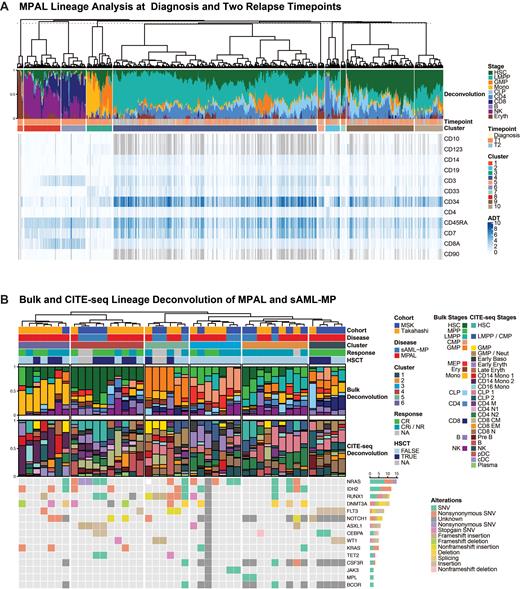Introduction:
Mixed phenotype Acute Leukemia (MPAL) is challenging due to ambiguous biology and lack of formal therapeutic guidelines. Although MPAL itself is rare, mixed phenotype lineage expression in secondary AML (sAML-MP) occurs with greater frequency and is associated with poor clinical outcomes. Multimodal single cell sequencing with cellular indexing of transcriptomes and epitopes (CITE-seq) offers more precise lineage characterization and assessment of lineage dynamics. Here we demonstrate a novel, unbiased approach to quantitative multistage hematopoietic lineage assessment in MPAL and sAML-MP using CITE-seq data. In addition, we demonstrate that this approach can be translated from single cell to bulk analysis.
Methods:
Sample preparation: Four MPAL and 6 sAML-MP samples displaying T-cell and myeloid subsets were identified and flow sorted into T and myeloid subgroups. RNA-seq was performed on each subset and analyzed using DESeq2. ComBat was used for batch correction when integrating with disparate data sources.
Single cell lineage deconvolution: CITE-seq samples were processed using Seurat. A single cell deconvolution library was constructed using previously published hematopoietic stage clustering and labeling, and applied to CITE-seq data from five MPAL samples in the same dataset. Deconvolution algorithm parameters were optimized through a bootstrapping approach on in-silico sample mixtures.
Bulk and translated lineage deconvolution: Bulk lineage deconvolution was performed using a published library of 13 stages of hematopoiesis derived from healthy donors.This was applied to bulk RNA-seq data from a cohort of published MPAL samples as well as the 6 sAML-MP and 4 MPAL samples described above. A pseudobulk was created for each CITE-seq lineage stage. Bulk lineage deconvolution was then re-run on the MPAL and sAML-MP samples using this library.
Clinical Outcomes: A Wilcoxon signed-rank test was used to analyze differences among deconvolution-derived patient clusters, including response to induction therapy, specific gene mutations, and likelihood of transplant.
Results:
Lineage evolution with treatment: Deconvolution was applied on 17,848 MPAL cells and 35,038 control PBMC/BMMC cells. Antibody Derived Tag (ADT) features were consistent with lineage deconvolution stage assignments. CD38 was negatively correlated with HSC (-0.34, p < 0.001) and LMPP (-0.18, p < 0.001) while CD34 was positively correlated with both HSC (0.11, p < 0.001) and LMPP (0.27, p < 0.001) stages. MPAL 5 in particular was assessed at diagnosis and at two later time points. Unsupervised hierarchical clustering of all timepoints resulted in 10 clusters ( Figure A). The diagnostic time point was largely contained in clusters 4 (LMPP character, N = 1545 cells, 37.13%) and 9 (HSC character, N = 756 cells, 18.16%). The majority of both relapse timepoints were within cluster 4, with 76.77% (N=357 cells) of T1 and 73.92% (N=1100 cells) of T2 located in it.
Bulk Unsupervised Analysis: Unsupervised analysis of sorted MPAL (N = 8), sorted AML-MP (N = 12), and unsorted MPAL (N = 24) bulk samples resulted in six distinct clusters, each with a distinct lineage signature ( Figure B). Some were enriched for more differentiated stages such as monocyte or GMP (clusters 6, 5), while others were enriched earlier stages such as LMPP (cluster 2). Secondary AML-MP samples were notably enriched in cluster 4. We found significant associations between lineage clusters and mutations in RUNX1 (p < 0.01), FLT3 (p = 0.004).
Clinical Outcomes: Bulk RNA deconvolution cluster was significantly associated with complete remission (p = 0.0009). On average, individuals with an incomplete/no response to induction chemotherapy had a higher NK signature (p = 0.001), while individuals assigned to transplant had decreased LMPP character (p = 0.0495). Among the single-cell stages, decreased CLP 2 levels were associated with a poor response (p = 0.0224) while CMP / LMPP (p = 0.040) and CD4 N2 (p = 0.022) levels were decreased in patients who were able to undergo HSCT.
Conclusions: Precise identification of lineage signatures in mixed phenotype leukemias shows promise in identifying clinically meaningful biological subsets of these diseases. Prospective analysis of lineage-derived biomarkers should be performed to undertake identification of formal risk stratification and treatment schemas.
Disclosures
Menghrajani:Gilead: Consultancy. Levine:AstraZeneca: Consultancy, Honoraria; Janssen: Consultancy; Qiagen: Membership on an entity's Board of Directors or advisory committees; Incyte: Consultancy; Isoplexis: Membership on an entity's Board of Directors or advisory committees; C4 Therapeutics: Membership on an entity's Board of Directors or advisory committees; Prelude: Membership on an entity's Board of Directors or advisory committees; Auron: Membership on an entity's Board of Directors or advisory committees; Zentalis: Membership on an entity's Board of Directors or advisory committees, Research Funding; Mission Bio: Membership on an entity's Board of Directors or advisory committees; Ajax: Membership on an entity's Board of Directors or advisory committees, Research Funding; Novartis: Consultancy; Roche: Honoraria; Lilly: Honoraria; Amgen: Honoraria.


